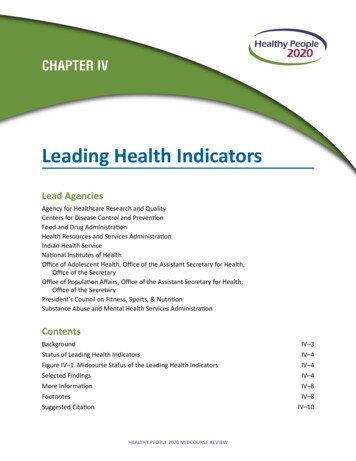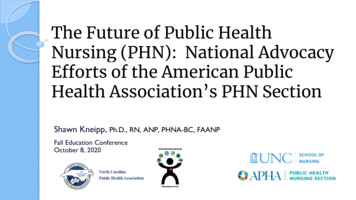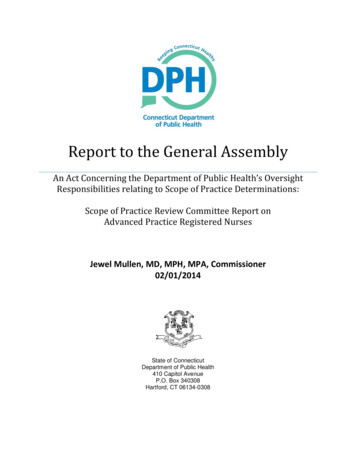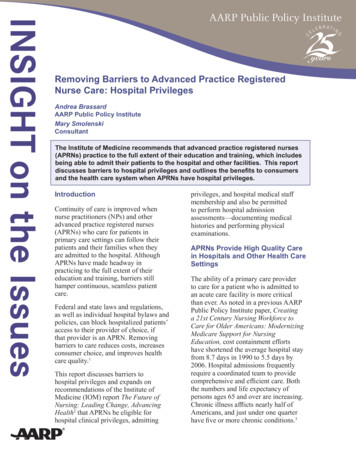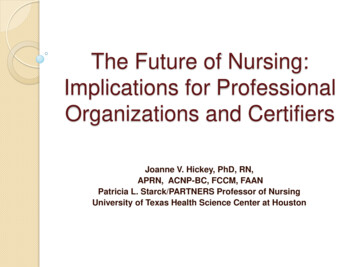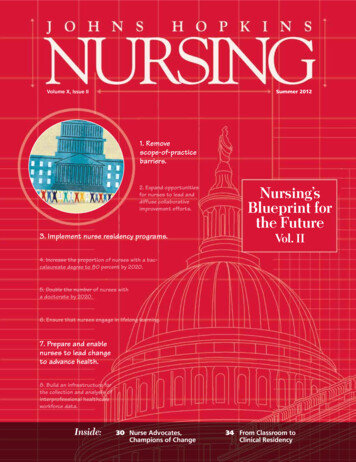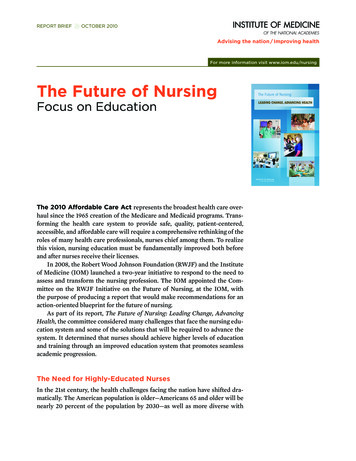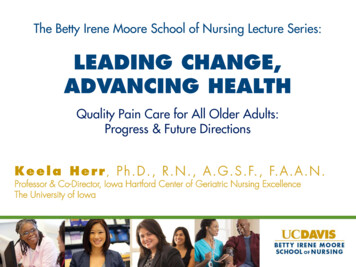
Transcription
The Betty Irene Moore School of Nursing Lecture Series:LEADING CHANGE,ADVANCING HEALTHQuality Pain Care for All Older Adults:Progress & Future DirectionsK e e l a H e r r , P h . D . , R . N . , A . G . S . F. , F. A . A . N .Professor & Co-Director, Iowa Hartford Center of Geriatric Nursing ExcellenceThe University of Iowa
Keela Herr, PhD, RN, AGSF, FAANProfessor & Co-Director, Iowa Hartford Center ofGeriatric Nursing ExcellenceThe University of Iowa
No Conflict of Interest Funding in past 12 months National Institutes for Health The Mayday Fund American Hospice Foundation
Discuss current state of pain carefor older adultsKey challenges and future directions
Aging of Society 65 Population Will Nearly Double by 2030 1 in 8 65 in 2007 (13% population) 1 in 6 65 in 2020 (20% population) Increased presence in health care 38%46%50%50%60%70%90%ofofofofofofofemergency medical services responsespatients in critical carehospital daysspecialty ambulatory care visitsadult primary visitshome health servicesresidents in nursing facilities(John A. Hartford Foundation, 2007; IOM 2008)
SettingPrevalence of painNursing Home (9952 OA/185 NHs)51.4% overall some pain78% mild cog impairment22% mod-severe cog impairment (Lapane et al., 2012)51-83% Present PainHospital (367 OA/8 hosp)67% pain present(Gianni et al., Arch Geront & Geriatrics, 2010)Home/Community(Eggermont et al., 2014; (634 OA))(Patel et al., 2013; 7601 OA)Hospice (738 OA with cancer/16 hospices)(Herr et al., 2012)65% chronic pain present53% bothersome pain83% pain present40% pain at admission and43% pain controlled on analgesics
In person interviews national sample 7601 adults 65 yrs Bothersome pain in last month 52.9% No change across age group accounting for cognitiveperformance, dementia, proxy report, residential care status Highest in women, obese, musculoskeletal conditions, depression 74.9% multiple sites of pain Associated with decreased physical function
Do we have reliable and valid painassessment tools for cognitively intact andimpaired older adults?Are tools integrated into practice to identifyand monitor pain in older adults across caresettings?What are key issues related to existing painassessment tool use in older adults?
Initial determinationor ongoing monitoringof painSelf-reports (uni andmultidimensional) &behavioralobservationPhysical exam, pharm eval, agerelated physical concerns, sensoryimpairment, functional assessment Medical,pharmacologic, andfunctional assessmentof pain-relatedconcerns Assessment ofpsychosocial factorscontributing to paincomplaintPsychosocial comorbidities andcomplicating factors, cognitiveprocesses, coping, affectiveprocesses, interpersonal processesHadjistavropoulos et al., 2007. Interdisciplinary expert consensus statement onassessment of pain in older persons. Clin J Pain, 23(1):S5
Number of tools evaluated in older adultsFurther support in recent years
Selected Pain Intensity Scales for Older Adults(Gagliese et al., 2005; Herr et al., 2007; Lukas et al., 2013;Personen et al., 2009; Wood et al., 2010)Simple VDS0 None1 Mild2 Moderate3 Severe(Closs et al., 2004)Iowa Pain ThermometerVerbal Descriptor Scale (VDS)NRSMost Intense Pain ImaginableVery Severe PainSevere PainModerate PainMild PainSlight PainNo Pain(Herr et al., 2004)McGill Present PainInventory (PPI)012345 No ng(Melzack & Katz, 1992)Faces Pain Scale-Revised(Hicks et al., 2001)(Herr et al., 2007)
Largest study (800) community elders attending tertiary pain clinic NRS as valid and reliable tool for measuring pain intensity and distress; Sign correlations with other pain measures Failure rates significantly increase with increasing age5.5% in 61-707.8% 71-8011.1% in 81CANNOT RELYSOLELY ON NRS75% over 75 yrs with reported ‘painful but bearable’equated NRS 4, 5, 6 this categoryQuestion standard cut-offs?
Geriatric hospital, 178 pts (Lukas et al, 2013) Good cross tool correlations; Lower @ rest, than movement Most stable tool with increasing CI: VRS Level of impairment for inability to use (MMSE 10)
Pain intensity—5th Vital Sign Pain impact scales—too time consuming? Interview—lack consistency? Backlash from patients related to repetitive assessments that don’t fullycapture their experience More patient-centered approach? Brief Pain Inventory—SF and adapted Pain Disability Index Geriatric Pain Measure--Short Form (GPM-12) Informal questioning—underestimates pain Pain Question phrasing (McGuire et al., 2009)(Lorenz et al 2009; van Dijk et al; 2012)Emphasis on impact/tolerability/satisfaction with treatment plan?
Adapted Functional Pain ScaleUsed with permission P. Arnstein
Biomarkersneuropeptides(Sowa et al., 2014)Schiavenato Pain Orb
Patient self reportPotential causes of pain (acute andchronic)Pain behaviorsSurrogate report and behavior changeResponse to analgesic trialHerr et al:, Assessment of Pain in Nonverbal Patients, Pain Mgmt Nurs, 2011Hadjistavropoulos et al, Interdisc Expert Consensus State., Clin J Pain, 2007
Now over 35 nonverbal pain tools Reviews Corbett et al., (2012). Rev Neurol, 8:264Herr et al., (2010). J Geron Nsg, 36:18Cohen-Mansfield (2008), Alzh Dis Assoc Disord, 22(1): 86Aubin et al. (2007). Pain Res Manag, 12:195Van Herk et al. (2007). Nurs Res, 56:34Herr et al., (2006). J Pain Symptom Manage, 31:170Zwakhalen et al. (2006). BMC Geriatr, 6:3No single best tool for all settings
Tools range from 5 behavioral categories to 60 individualbehaviors— rating presence vs intensity Variable use and definition of behaviors Are there key behaviors that will ID pain in most personswith dementia?Need to discriminate pain behavior and behaviors fromother causes (Ersek leading VA study)Goal to identify most specific indicators of pain innonverbal older persons without missing pain in those withless typical behaviors
Support of Atypical Pain Behaviors Growing Cluster RCT 18NH-352 subjects Verbal agitationbehaviors andrestlessness andpacing responsiveto treatmentPain interventionseffective in reducingpain and behavioralsymptoms, such asdepression,agitation/aggression,anxiety
Most tool scores show increase/decrease in behavior orintensity of behavior Cutoff scores: limited evidence, small scale evaluation Challenge for treatment decisions
Pain Mgt Nsg, 2011, 12(4):23050
Setting Hospital(Mehta et al., 2010)SamplePain Assessment?100 pts mean age 8662% hip fracture33% no objective assessment bynursing95% no obj assess by MDAssessmentof Pain with Valid &14 NH (8 not profit; 6 for 32% Pain assessed weeklyprofit)25% Mild pain-2x/mo(Jablonski & Ersek et al., 2009)ReliablePain ToolsMod pain-weekly291 residents with painNOT CONSISTENTNursing HomeHospice(Herr et al., 2012)738 from 16 hospicesMean age 7883% pain80-86% valid pain scale at adm15-16% reassess with modsevere painCog impaired—no validated painbehavior tool
*Quality/frequency ofassessmentsGoal: Optimal PainRelief*Optimized nondrugapproaches*Balance risk/benefits andoptimize r & documentoutcomes(AGS Panel on the Pharmacological Management ofPersistent Pain in Older Persons. JAGS, 2009;57(8):13311346; Arnstein & Herr, J Geron Nsg, 2013: 39(4):56-66;Bruckenthal P, et al. Pain Medicine. 2009;10(S2):S67-S78)
Do we have evidence to support pharmacologic andnonpharmacologic intervention selection andtailoring for older adults?Are evidence-based pain management practicesimplemented consistently?Key issues to effective pain management?
Patient educationExercise (therapeutic, physical therapy, general, yoga,Tai Chi)Self-management programs (acceptance/commitment tx, coping)Cognitive and behavioral therapies (biofeedback)Distraction (music, humor)Relaxation (imagery, hypnosis, massage, meditation)Thermal treatments (heat, cold)Assistive devices (splinting, orthotics, positioning)Energy Field therapy (healing touch, reiki)Acupuncture/acupressure, TENSAromatherapy and other CAM(Arnstein, 2011; Bruckethal, 2010; McCauley et al., 2008; Morone & Greco, 2007; Park& Hughes, 2012;Reid et al, 2008; Shengelia et al., 2013; Tse, Wan & Ho, 2011)
Gaps Effectiveness in real world outcomes on pain and functionUse in frail and cognitively impairedGuidance in patient selectionTechniques and formatsAvailability—access, technology, fundingPreference & AdherenceSustaining effect
JAGS, 2009, 57:1331-1324
Revised 2012
SettingPrevalence of painNo Pain Treatment?Nursing Home (2508 OA/185Random sample all withpain in two MDSassessments23% no scheduled meds Age and cog impairmentless likely67% pain present51% no treatment orinadequate for intensityNHs)(Lapane et al., 2013)Treatment of PainNOT CONSISTENTHospital (367 OA/8 hosp)(Gianni et al., Arch Geront &Geriatrics, 2010)Emerg Dept (7,585 ED visits 75or older)(Platts-Mills et al., 2012)Home Care (2779 OA)(Maxwell et al., 2008)All pain-related ED visits48% daily pain51% no analgesics(compared to 32% 35-54 yrs)22%
Provider Knowledge Gaps No consistent training on geriatrics and/or pain Knowledge to balance benefits/risk for best treatment plan Knowledge Gaps Re: Analgesic Use in Older Adults Strength of evidence in existing pain guidelines for older adults Limited research on analgesic use in older adults specifically the complex including cog impaired Political/Regulatory Climate National Public Health Concerns Re Opioid Misuse/Abuse (CDC) Federal concern re: safe and effective analgesic use (FDA; NIA;NIH Pain Consortium) PROP—physicians for responsible opioid prescribing DEA requirements for opioid prescriptions in VA(Kaasalainen et al., 2010, 2012;Taylor, Lemtounti, Weiss & Pergolizz, 2012, Current Geron & Ger Res,12;Chou et al., 2009, J Pain, 10(2):113-130)
“Panel Conclusion: “Evidence is insufficient to determine the evidencefor long-term opioid therapy for improving chronic pain and function.Evidence supports a dose-dependent risk for serious harms.”Panel Recommendation:“In the absence of definitive evidence,clinicians and health systems should follow current guidelines byprofessional societies about which patients and which types of pain should dwith opioidsabouthow bestAmericanto monitorpatientsand mitigate riskAmerican Academy of Pain Medicine, American Association forfor harm.”Pain Management Nursing
OngoingChallenge
Greater awareness of the impact of pain Validation of painassessment scales and approachesCHALLENGE:to assessment in cognitively impaired Determiningand monitoring effect ofofpain onImplementationfunction and quality of life and individualizing paincare planBest PracticesRecognition of the importance of multimodal therapyGrowing evidence base to support analgesic therapyand nonpharmacologic approaches
Findings:*Cultural transformation needed in waypainis viewed andcentraltreatedEducationpart oftransformation*Chronic pain viewed as disease itself*Pain is a public health problem*More consistent data on pain needed*Population-based strategies neededResearchtranslate*Significantbarrierstoto adequatepain careadvances into effectivetreatments
Led by Dr. Judy Watt-Watson14: 971-981.Funded by The Mayday Fund
NIH Pain Consortiumpartnership with 12 schoolsDevelop, evaluate anddistribute pain managementcurriculum resources forhealth professional schoolsIncludes older adult contentNew Center Funding ExpectedSpring 2015
http://www.geriatricpain.orgFunding fromThe MaydayFund
Refined Assessment ApproachesCollaborative/interdisciplinary Selectingand Adapting Complementary andresearch teamsAlternative Therapies Safety & Efficacy & Effectiveness of Analgesics ImplementationIncreasedStrategies fundingto Promote EBP Use
Reid et al., 2011RFA 2011: Leveraging ExistingData or Longitudinal Studies toEvaluate Safety and Effectivenessof Pharmacological Managementof Chronic Pain in Older Adults
Visiting ng/Game playingSwim/WaterExercise
The Betty Irene Moore School of Nursing Lecture Series: LEADING CHANGE, ADVANCING HEALTH Quality Pain Care for All Older Adults: Progress & Future Directions Keela Herr, Ph.D., R.N., A.G.S.F., F.A.A.N. Professor & Co -Director, Iowa Hartford Cent
